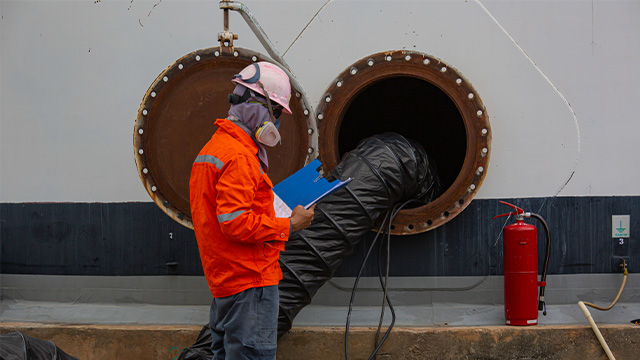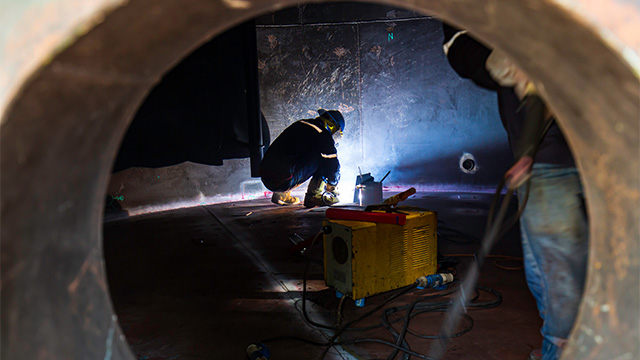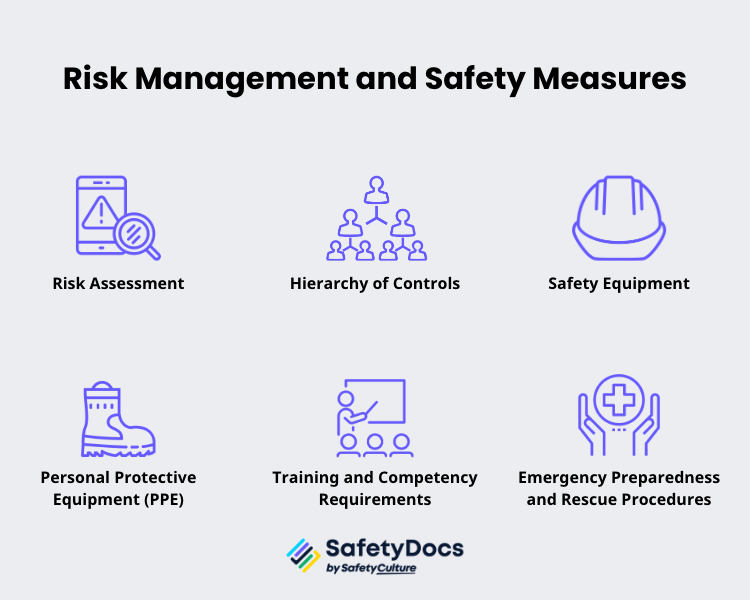In January 2018, two workers were discovered dead inside a fibreglass tank on a purpose-built tri-axle trailer in Australia. The circumstances surrounding their deaths were related to the cleaning process of the tank. The tragedy hit home for many industries, highlighting the potential risks when working in a confined space.
In this article, we will explore the definition of confined spaces, discuss the regulations and standards set by Australian authorities, identify the hazards associated with working in confined spaces, and provide recommendations for maintaining safety in such environments.
Definition of Confined Space
Before delving into the safety aspects, it is crucial to understand what a confined space is. In Australia, a place is a confined space if:
- It is not intended for continuous occupation by humans.
- It has limited access and egress points.
- It poses a risk of injury or harm due to hazardous substances, dangerous conditions, or the design or layout of the space.
Confined spaces are determined by the specific hazards present rather than merely based on being small in size. Entering a confined space means a person's head or upper body is inside its boundaries. Common examples of confined spaces include vats, tanks, silos, sewers, wells, shafts, trenches, underground sewers, tunnels, or other enclosed or partially enclosed structures that meet the definition provided in the WHS Regulations.
What is not considered a confined space?
According to the WHS Regulations, the following are not considered confined spaces:
- Trenches that are not at risk of structural collapse. Trenches are not automatically confined spaces because of the risk of structural collapse alone. However, they will be classified as confined spaces if they potentially contain concentrations of airborne contaminants that could lead to impairment, loss of consciousness, or asphyxiation.
- Workplaces that have adequate ventilation, lighting, and safe means of entry and exit. Common examples include office buildings, storage areas, and workshops.
- Enclosed or partially enclosed spaces that occasionally have harmful airborne contaminants. This includes areas such as abrasive blasting or spray painting booths. If the concentration of airborne pollutants is not high enough to cause health issues, then the space will not be a confined space.
- An emergency service worker can enter a confined space if the worker rescues or protects someone. Emergency services can enter a confined space to carry out life-saving measures, such as saving someone trapped or providing medical assistance.
Jobs requiring working in confined spaces
Several jobs may require a person to work in confined spaces due to the nature of the tasks involved. Some of these occupations include:
- Tank cleaners: Individuals responsible for cleaning and maintaining storage tanks, such as those used in the oil and gas industry.
- Utility workers: Employees working with water, gas, or sewer systems may need to enter underground pipes, manholes, or vaults.
- Shipyard workers: Those working in shipbuilding or ship repair may need to enter confined spaces within a ship's hull, such as fuel tanks, cargo holds, or engine rooms.
- Maintenance technicians: Maintenance workers in various industries, such as chemical plants, power plants, or manufacturing facilities, often need to access spaces like ducts, tunnels, or crawlspaces to perform equipment maintenance or repairs.
- Tunnel and mining workers: Miners and tunnel construction workers frequently work in underground mines, tunnels, or shafts.
- Silo workers: Employees responsible for maintaining or cleaning silos in the agricultural industry
- HVAC technicians: Professionals who install, maintain, or repair heating, ventilation, and air conditioning systems may need to access ductwork or crawlspaces.
- Emergency responders: Firefighters, paramedics, and other emergency response personnel may need to enter confined spaces during search and rescue operations or when dealing with hazardous materials incidents.
It is essential for individuals working in these occupations to receive proper training and follow all safety precautions and protocols to minimise risks associated with working in confined spaces.

Risks of working in a confined space
When working in enclosed spaces, it's vital to be aware of the significant health and safety risks and hazards involved. Some of the potential hazards associated with working in a confined space include:
- Oxygen deficiency: Confined spaces can have limited airflow, leading to dizziness, unconsciousness, and even death.
- Toxic atmosphere: Some confined spaces may contain harmful airborne contaminants such as gases, vapours or dust. This can cause injury from fire or explosion or even lead to poisoning.
- Engulfment or entrapment: Working in a confined space may increase the risk of engulfment, where an individual could be trapped by loose material or liquids and suffocate.
- Fire and explosion: Confined spaces with flammable materials can ignite or explode, causing severe injuries and even fatalities.
- Temperature extremes: Confined spaces can have extreme temperatures, leading to heat exhaustion, dehydration, or frostbite.
- Fall from heights: There are chances of falling if the confined space is at a high location, such as a rooftop, an elevated floor, or even a ladder.
- Poor lighting: This can make conditions challenging to navigate, thus increasing the risk of slips, trips and falls.
Working in confined spaces poses significant biological hazards and risks. Therefore, prioritising safety measures becomes pivotal. Working in such environments presents various dangers. Strict safety measures are essential to minimise accidents and mitigate risks.
Duty Holders and their Roles
Who is responsible for the safety of personnel working in confined spaces? Laid out in the Code of Practice for confined spaces, there are specific duty holders who have certain responsibilities to ensure the safety and health of workers.
1. Persons conducting a business or undertaking (PCBUs)
The specific duties of a person conducting a business or undertaking (PCBU) in managing risks in confined spaces are as follows:
- A PCBU must ensure they effectively manage any risks associated with a confined space in their workplace.
- A PCBU must remove any potential hazards associated with working in cramped spaces, or if that is not feasible, reduce the risks as much as possible.
- A PCBU must identify, assess, and control hazards and risks.
2. Designers, manufacturers, importers, suppliers, installers and constructors of plants, substances or structures
- They must ensure that the design and construction of the confined space minimise any risk associated with working in it.
- They ensure that the plant, substance or structure is safe for everyone involved, including those who store or maintain it.
- They must obtain or provide information to help other people manage plant health and safety risks.
3. Officers
- Officers must ensure that the PCBU is diligent in its duties of managing risks in confined spaces.
- Officers should also ensure that workers receive appropriate instruction, information, training and supervision when working in a confined space
4. Workers
- Workers must follow the instructions regarding entry into a confined space their employer provides.
- Workers must abide by the safety measures put in place by their employers and report any unsafe conditions immediately.
- Workers have a duty of care to themselves and others in the workplace. They must take reasonable care of their own health and safety and other people's.

Australian Legal Requirements and Regulations for Working in Confined Spaces
In Australia, several regulations and standards govern working in confined spaces. The most notable one is the Work Health and Safety (WHS) Act 2011, which sets out the legal obligations of employers and employees. Here are some of the other regulations and standards that are applicable when working in confined spaces:
Code of Practice: Confined spaces
The Code of Practice for managing risks in confined spaces at workplaces is an approved guide under the relevant Work Health and Safety Acts). It helps achieve the required health, safety, and welfare standards by providing practical guidance. The code applies to anyone with a duty of care, and following it ensures compliance with the WHS Act. While codes of practice address specific issues, duty holders must consider all risks related to work, even those without regulations or codes in place.
Work Health and Safety (WHS) Act 2011
The guidelines for working in confined spaces are set out in the Work Health and Safety Regulations for your state or territory.The outline the responsibilities of employers, workers, and other duty-holders when working in confined spaces. It also contains specific requirements for ventilation, air monitoring systems, emergency communication systems, and signage.
Australian Standard AS 2865-2009
The Australian Standard AS 2865-2009 is an important guideline that provides recommendations and best practices for managing and controlling confined spaces in Australia. This standard aims to assist employers, duty holders, and workers in understanding and implementing effective measures to ensure the health and safety of individuals working in confined spaces.
Confined Space Entry Permit
A Confined Space Entry Permit is a crucial document that outlines the necessary precautions and safety measures to be taken before, during, and after operating in a confined space. Here are a few reasons why this permit holds such significant value:
- Risk Identification and Management: The permit process requires identifying and thoroughly assessing potential hazards before entry. This could include oxygen deficiency or enrichment, presence of toxic gases, potential for engulfment, or the risk of fire or explosion.
- Safety Measures: Based on the identified risks, safety measures are defined and documented. These may include use of personal protective equipment (PPE), isolation or lockout/tagout procedures
- Accountability: The permit process ensures accountability by specifying the roles and responsibilities of all involved personnel, including the entrant(s), attendant(s), and entry supervisor.
- Monitoring and Communication: The permit outlines the means of ongoing hazard monitoring and establishes communication procedures between entrants and attendants to maintain safety throughout the entry process.
- Emergency Preparedness: A key component of the permit is the planning and readiness for potential emergencies, including rescue and evacuation procedures.
- Documentation and Review: Finally, a Confined Space Entry Permit provides a written record of the steps taken to ensure safety. This allows for review and continuous improvement of safety procedures and protocols.
In conclusion, a Confined Space Entry Permit is a vital tool for managing safety in environments where workers must operate in confined spaces. It enables a systematic approach to risk identification, hazard management, and emergency preparedness, contributing significantly to the overall safety of the workplace.

Risk Management and Safety Measures
1. Risk Assessment
Conducting a thorough risk assessment is fundamental in managing confined space hazards. Under the WHS Regulations, a risk assessment is compulsory for confined spaces. The PCBU ensures that a qualified individual performs the risk assessment and records it in writing.
The risk assessment should involve the following:
- Identifying potential hazards
- Evaluating the likelihood and consequences of hazards
- Implementing control measures to eliminate or minimise risks
- Regularly reviewing and updating the risk assessment as necessary
Control measures may include
- proper ventilation,
- isolation of hazardous substances,
- use of safety equipment, and
- implementation of safe work procedures.
2. Hierarchy of Controls
The duty holders must adhere to the hierarchy of control measures outlined in the WHS Regulations when managing certain risks, including confined space hazards. The hierarchy of controls is an organised approach to mitigating risks, with the most effective controls placed at the top of the list.
The steps in the hierarchy of control measures are:
- Elimination – Removing the hazardous substance from a confined space
- Substitution – Replacing the hazardous substance with a less hazardous one
- Engineering control measures – Installing appropriate ventilation systems
- Administrative control measures – Implementing safe work procedures and providing training to workers
3. Safety Equipment
In addition to the necessary control measures, employers must provide appropriate safety equipment when working in confined spaces. This includes but is not limited to a full body harness, breathing apparatus and air supply systems (if needed), gas detectors, emergency communication devices, rescue equipment, torches/lighting solutions, and signage.
4. Personal Protective Equipment (PPE)
Personal Protective Equipment (PPE) plays a crucial role in ensuring the safety of workers in confined spaces. The type of PPE should be according to the particular risks in the area. Employers must provide sufficient and appropriate PPE for their workers in confined spaces. They are also responsible for ensuring that all PPE is appropriately maintained and tested following the manufacturer's instructions.
PPE may include:
- Respiratory protective equipment
- Protective clothing
- Safety harnesses and lifelines
- Head protection
- Eye and ear protection
- Breathing apparatus
5. Training and Competency Requirements
Proper training and competency are vital for working safely in confined spaces. Employers must ensure that workers receive comprehensive training on the following:
- Hazards associated with confined spaces
- Correct use of safety equipment
- Emergency procedures and rescue techniques
- Risk assessment and control measures
Conduct regular refresher training to maintain employees' competency and update them with the latest safety practices.
6. Emergency Preparedness and Rescue Procedures
Being well-prepared can save lives in critical situations. Employers must prepare emergency plans and have emergency response procedures, for any eventuality. The PCBU is responsible for establishing appropriate workplace first aid and rescue procedures. Workers must practise these procedures to ensure their efficiency and effectiveness regularly.
Emergency plans should include the following:
- Emergency contact information
- Evacuation plan
- Rescue procedures
- Any necessary medical and first aid equipment
- Clear communication methods
- Emergency response team roles and responsibilities
- Availability and use of rescue equipment
- Coordination with external emergency services
- Regular drills and practice scenarios
Equip Your Team With Safety Documents from SafetyDocs
From risk assessments to safety plans, SafetyDocs by SafetyCulture has a range of documents available to equip your team with the best safety practices and safety procedures used for working in confined spaces. Experienced safety experts develop our documents and cover safety management plans, risk assessments, safe operating procedures, method statements, etc.
With SafetyDocs, you can rest assured that your workers are ready for any hazardous tasks. Browse our library of safety documents and start with these tools for working in confined spaces:
- Confined Space Management Plan
- Confined Space Work Safe Work Method Statement
- Confined Space Emergency Rescue Plan
- Lock Out Tag Out (LOTO) Safe Work Method Statement
Contact us to find out more about how you can start developing a safety culture in your workplace.
Our team of experts is dedicated to providing accurate and informative content. Craig Cruickshank, our senior HSEQ advisor at SafetyDocs by SafetyCulture has reviewed this blog post to ensure the highest level of quality.
Learn more about Craig's work on LinkedIn for more industry insights.
Available for instant download and supplied in fully editable MS Word format for use in your business.
Please note that the above information is provided as a comment only and should not be relied on as professional, legal or financial advice.
Share This Article
